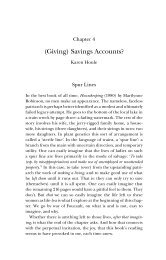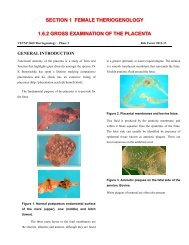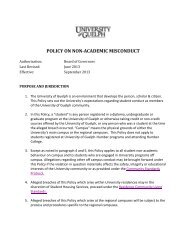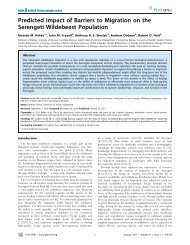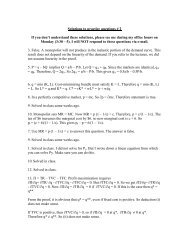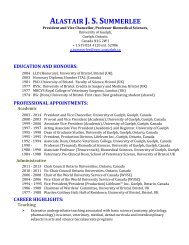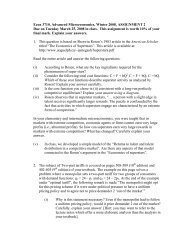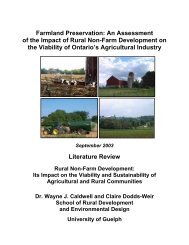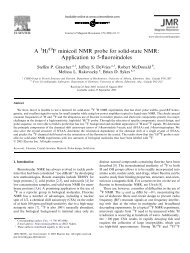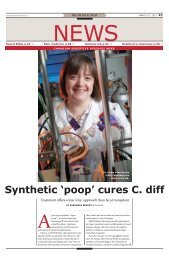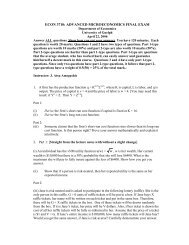The biology of Canadian weeds. 117. Taraxacum officinale G. H. ...
The biology of Canadian weeds. 117. Taraxacum officinale G. H. ...
The biology of Canadian weeds. 117. Taraxacum officinale G. H. ...
You also want an ePaper? Increase the reach of your titles
YUMPU automatically turns print PDFs into web optimized ePapers that Google loves.
Collins (2000) found that the mean mass (mg) per seed in<br />
the UWO collection ranged from 0.33 mg in an August collection<br />
to 0.68 mg in a late October collection. At the peak<br />
<strong>of</strong> flowering in May, it ranged between 0.43 and 0.49 mg.<br />
<strong>The</strong> seeds produced in late October and early November<br />
were significantly (P = 0.05) heavier than those produced at<br />
other times <strong>of</strong> the year. UK reports <strong>of</strong> seed weights vary,<br />
with Salisbury (1961) stating an average weight <strong>of</strong> 0.8 mg,<br />
Bostock (1978) reporting an average seed weight <strong>of</strong> 0.583<br />
mg, while Sheldon (1974) reported the average seed<br />
weighed 0.0549 mg; one-tenth as much as in any other<br />
report. Also, the average seed was reported as 10.25 mm in<br />
length, with a pappus diameter is 6.94 mm (Sheldon 1974).<br />
(c) Seed banks, seed viability and germination. Very large populations<br />
<strong>of</strong> T. <strong>of</strong>ficinale seeds can be found in soil. For example,<br />
in the UK, Champness and Morris (1948) found 1 575 000<br />
seeds ha –1 in the top 13 cm <strong>of</strong> soil in a grassland area, and<br />
2 350 000 seeds ha –1 in the top 18 cm <strong>of</strong> an arable field.<br />
At least 7 d must elapse after the opening <strong>of</strong> the inflorescence<br />
before most seeds <strong>of</strong> T. <strong>of</strong>ficinale are mature enough<br />
to germinate (Longyear 1918). <strong>The</strong>refore, if all inflorescences,<br />
including those that have closed to ripen the seeds,<br />
are removed from the plant (e.g., by mowing), the germination<br />
<strong>of</strong> seeds from the dried inflorescences that have ripened<br />
after cutting is only 13% (Longyear 1918; Roberts 1936).<br />
Fully mature seeds <strong>of</strong> T. <strong>of</strong>ficinale lack primary dormancy<br />
and are able to germinate almost as soon as they leave the<br />
plant (Longyear 1918; Martinková and Honĕk 1997).<br />
However, the proximity <strong>of</strong> the seeds to each other influences<br />
germination. In a US study, seeds placed singly or in groups<br />
<strong>of</strong> 5, 10 or 25 had germination percentages <strong>of</strong> 68, 64, 54 and<br />
41%, respectively. This significant decrease in germination<br />
with increasing density may be a population-regulating<br />
mechanism (Linhart 1976).<br />
<strong>The</strong> germination capacity <strong>of</strong> T. <strong>of</strong>ficinale seeds is generally<br />
80–90% (Falkowski et al. 1989), and Martinková and<br />
Honĕk (1997) reported 94% germination on moist filter<br />
paper, 28 d after collection. Most seeds germinate within<br />
1.5 mo after dispersal (Ogawa 1978). However, von H<strong>of</strong>sten<br />
[quoted by King (1966)] estimated that, <strong>of</strong> 10 000–20 000<br />
seeds m –2 dispersed into a meadow, only 50–125 would<br />
establish successfully. Germination is impaired after passage<br />
through the digestive tracts <strong>of</strong> cattle, with germination<br />
<strong>of</strong> 52%, 31% and 22% after retention in faeces for 5 h, 24 h<br />
and 48 h, respectively (Falkowski et al. 1989, 1990).<br />
Germination is also influenced by individual seed weight<br />
(Tweney and Mogie 1999). <strong>The</strong>re is variation in the weight<br />
<strong>of</strong> seeds produced in a single inflorescence and the heavier<br />
seeds have a greater probability <strong>of</strong> germination (Tweney<br />
and Mogie 1999).<br />
Seeds <strong>of</strong> T. <strong>of</strong>ficinale germinate over a wide range <strong>of</strong> temperatures,<br />
from 5–35°C (Mezynski and Cole 1974;<br />
Washitani 1984), with less germination at higher temperatures<br />
(Martinková and Honĕk 1997). Most reports indicate<br />
that seeds <strong>of</strong> T. <strong>of</strong>ficinale germinate best under alternating<br />
temperatures and light. Collins (2000) found 85–94% <strong>of</strong><br />
seeds, from two populations from London, ON, germinated<br />
under the following regimes: 15°C/5°C with 9 h light,<br />
STEWART-WADE ET AL — TARAXACUM OFFICINALE G. H. WEBER EX WIGGERS 837<br />
25°C/10°C with 14 h light, 35°C/20°C with 15 h light and<br />
25°C/10°C in total darkness. However, other temperature<br />
regimes in total darkness led to reduced germination, with<br />
only 75% at 35°C/20°C and 43% at 15°C/5°C. Cross (1931)<br />
found 75–76% <strong>of</strong> seeds, collected from Ottawa, ON, germinated<br />
in alternating temperatures <strong>of</strong> 30°C/20°C, while only<br />
60–65% germinated at a constant temperature <strong>of</strong> 18–20°C.<br />
Mezynski and Cole (1974) reported maximum germination<br />
<strong>of</strong> fresh seeds, collected from Maryland, USA, at an alternating<br />
temperature <strong>of</strong> 20°C for 16 h and 10°C for 8 h (while<br />
seeds stored for 30 d germinated best at 20°C/15°C).<br />
Maguire and Overland (1959) found that 92% <strong>of</strong> seeds, collected<br />
from Washington State, USA, germinated at alternating<br />
temperatures (30°C/20°C) in alternating light and<br />
darkness, but when kept in darkness, there was only 72%<br />
germination. Also, at a constant temperature <strong>of</strong> 15°C in<br />
dark, only 4% germination was recorded, but when alternating<br />
light and dark was added to the same constant temperature,<br />
96% germination was observed. Two British studies<br />
(Thompson 1989; Williams 1983) reported similar results.<br />
Seed germination was greater, faster and more uniform in<br />
light than in dark (Isselstein 1992; Letchamo and Gosselin<br />
1996). In a Swedish study, Noronha et al. (1997) used cold,<br />
dark stratification to show that seeds <strong>of</strong> T. <strong>of</strong>ficinale have an<br />
inducible light requirement for germination. Ecologically,<br />
this inducible light requirement is important for preventing<br />
the germination <strong>of</strong> buried seeds in conditions unfavourable<br />
to seedling development (Noronha et al. 1997).<br />
<strong>The</strong>re are varying reports <strong>of</strong> the viability <strong>of</strong> seeds <strong>of</strong> T.<br />
<strong>of</strong>ficinale after storage. Following burial <strong>of</strong> T. <strong>of</strong>ficinale<br />
seeds for varying time periods, a small number <strong>of</strong> seeds<br />
(1%) were still viable for up to 9 yr after burial (Burnside<br />
et al. 1996). Typically, 1–6% <strong>of</strong> T. <strong>of</strong>ficinale seeds remained<br />
viable 4 yr after burial in soil, and soil storage for 5 yr or<br />
longer resulted in little detectable viability (Chepil 1946;<br />
Roberts and Neilson 1981). Seeds remained viable longer in<br />
the soil (up to 20–30 yr) than when dry-stored indoors (von<br />
H<strong>of</strong>sten 1954). Depth <strong>of</strong> seed burial was negatively correlated<br />
to establishment success (Bostock and Benton 1983).<br />
Storage <strong>of</strong> seeds at room temperature decreased seed viability,<br />
compared to storage at 4°C (Letchamo and Gosselin<br />
1996). Mezynski and Cole (1974) reported that percentage<br />
germination decreased during 30 d storage <strong>of</strong> seeds at –15°C<br />
or 22°C, compared to fresh seeds. Al-Hially (1991) found<br />
that the rate <strong>of</strong> germination increased after 90 d storage.<br />
<strong>The</strong> position <strong>of</strong> T. <strong>of</strong>ficinale seeds affects germination,<br />
with greatest germination occurring when there is good contact<br />
between the substrate and the scar <strong>of</strong> attachment <strong>of</strong> the<br />
seed, allowing water uptake (Sheldon 1974). <strong>The</strong> hygroscopic<br />
pappus can move to alter the seed position as humidity<br />
changes and, in high humidity, the pappus closes<br />
hygroscopically (Sheldon 1974). <strong>The</strong> backward-pointing<br />
hairs and teeth <strong>of</strong> the seed may play a role in firmly anchoring<br />
it during seedling establishment (Sheldon 1974).<br />
Increasing soil compaction decreases seed germination,<br />
radicle penetration and seedling establishment, partly due to<br />
removal <strong>of</strong> microsites (Sheldon 1974).<br />
<strong>The</strong> endosperm <strong>of</strong> T. <strong>of</strong>ficinale is cellular and the uninucleate<br />
cells have meagre cytoplasm. At the globular stage <strong>of</strong>



